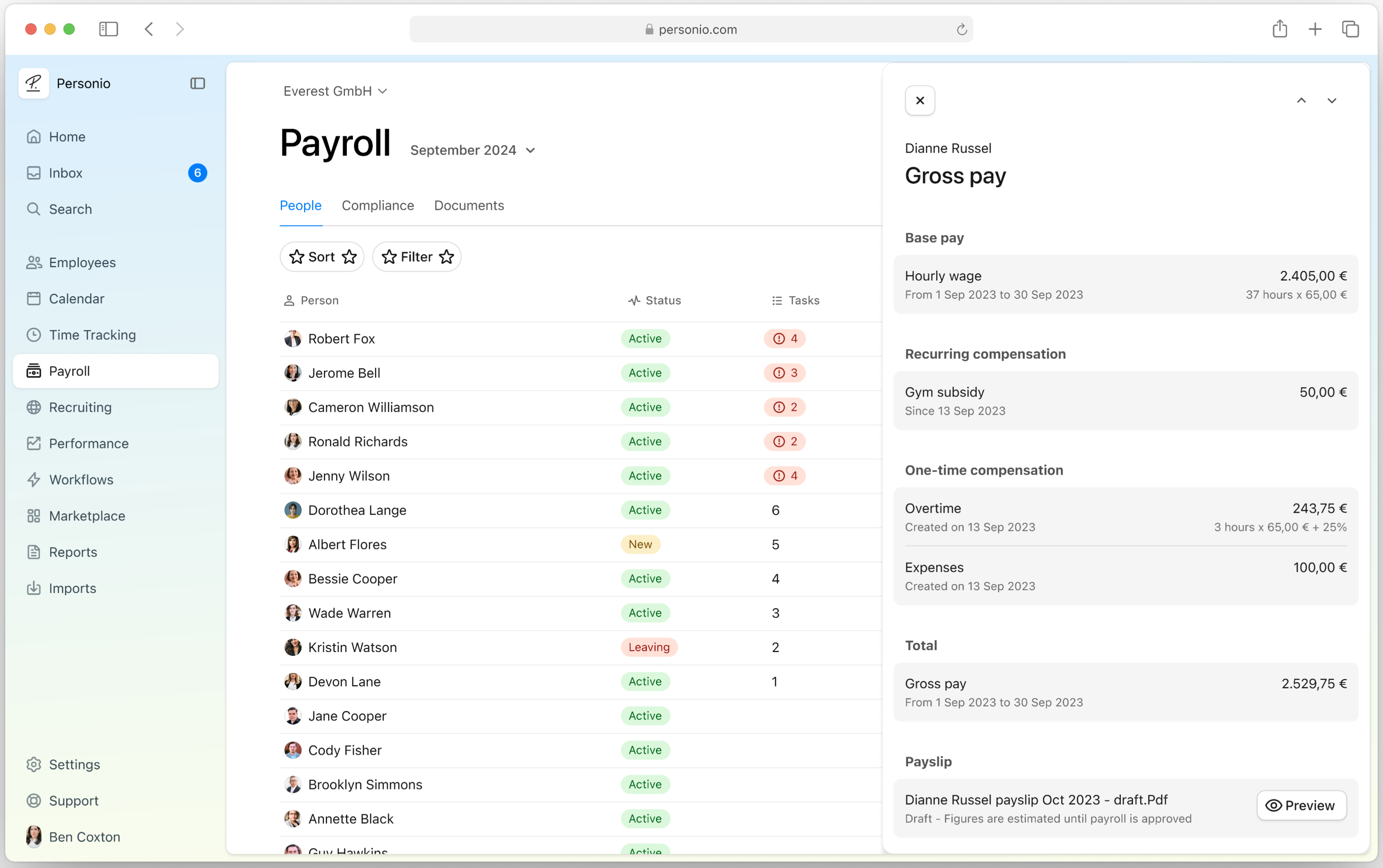UK employer pension contributions calculator + guide

Workplace pension schemes aren’t just a mandatory employee benefit in the UK; they’re also critical for holding onto your best people. The CIPD Good Work Index 2023 reveals that unsatisfactory pay and benefits are the leading reasons people leave their jobs, and providing adequate and appealing pension contributions can increase employee satisfaction and retention rates.
In this guide, we share essential information for contributing to your employees’ pension schemes and provide practical steps for calculating contributions.
Note: Since workplace pension scheme requirements vary between countries, this guide is tailored to businesses located in the UK.
Contents
- 1How to know if you have to contribute to your employees’ pensions
- 2Automatic vs. voluntary enrolment in pension schemes
- 3How do you calculate pensionable earnings?
- 4Can you contribute more than the minimum amount to your employees’ pensions?
- 5How to calculate and pay pension contributions for your employees
- 6Employer pension contributions calculator
- 7Run smoother payroll and get pension contributions right every time
- 8Frequently asked questions about employer pension contributions
How to know if you have to contribute to your employees’ pensions
Pension contributions are one of the basic costs to employ someone. As an employer in the UK, you're required to contribute to your employees' pensions if they:
Find themselves between 22 and the state pension age
Earn more than £10,000 a year
Work in the UK
If an employee meets these criteria, they’ll be automatically enrolled in a pension scheme. Automatic enrolment is a legal requirement, meaning employers must contribute to employee retirement savings when they’re automatically enrolled.
Current guidelines set the minimum contribution rates for both parties at:
At least 3% of qualifying earnings for employer contributions
At least 5% of qualifying earnings for employee contributions
So the total minimum contribution for an employee’s pension comes to 8%. Failing to comply can result in penalties and enforcement actions from the government pensions regulator, including hefty fines on top of paying back missed contributions.
Automatic vs. voluntary enrolment in pension schemes
There are two kinds of pension contributions: automatic and voluntary enrolment. Your requirements and contributions vary depending on the type of enrolment.
Requirements for automatic enrolment
Automatic enrolment is a government-mandated system that ensures employees save for their retirement. If your employees meet the criteria for automatic enrolment — which we outlined above — you must contribute a minimum of 3% of their qualifying earnings to their pension.
An employee’s contributions (minimum 5%) should be taken directly from their paycheck, with employers adding their own contributions on top of this amount. The employer should pay both contributions directly into the pension scheme.
Requirements for voluntary enrolment
Voluntary enrolment applies to employees who don’t meet the criteria for automatic enrolment but wish to join a pension scheme anyway. Employers aren’t legally obligated to pay voluntary workplace pensions, but doing so demonstrates their commitment to the financial wellbeing of their employees.
On the plus side, workplace pensions for both voluntary and automatic enrolment are tax-deductible business expenses – meaning you can decrease your taxable income by contributing to your employees' pensions.
How do you calculate pensionable earnings?
There are three ways to calculate how much of your employees’ earnings will count towards their pension contributions: basic pay, total earnings and qualifying earnings.
Basic pay
This is the most straightforward way to calculate pension earnings. In this case, the employee’s pensionable earnings are their basic salary before any bonuses, overtime or commission.
So if an employee’s base annual salary was £20,000, you would be responsible for paying £600 in pension contributions per year. You would also deduct £1,000 from that employee's paycheck for their individual pension contributions, totalling to £1,600 in pension contributions.
Total earnings
Total earnings refers to everything earned in someone’s employment, including current salary, wages, bonuses, overtime and commission. However, this doesn’t include any income from dividends.
If the employee we mentioned above earned an extra £5,000 in commission, their total annual earnings would come out to £25,000. In this case, you would be responsible for paying £750 in pension contributions per year. You would also deduct £1,250 from that employee's paycheck for their individual pension contributions, totalling to £2,000 in pension contributions.
Qualifying earnings
Qualifying earnings have lower and upper limits and are another way to calculate pensionable earnings. The lower limit establishes a minimum salary band that doesn’t count towards an employee’s pension earnings, while the upper limit sets a cap on earnings requiring pension contributions. This means you’re only obligated to contribute a percentage of your employee’s earnings that falls between these limits.
Pension contribution thresholds may change every tax year, so visit the Pensions Regulator site for the latest limits. In the 2024/25 tax year, for instance, the lower limit is set at £6,240, and the upper limit is £50,270.
Here are a couple of examples of how to calculate pension payments based on an employee’s qualifying earnings:
If an employee earns £10,000 a year, only £3,760 (£10,000 - £6,240) is considered for pension contributions. In this scenario, you need to deduct £188 from their annual paycheck to cover the minimum 5% employee pension contribution. You then add £112.80 to the pension pot, covering your 3% contribution.
If an employee earns £100,000 a year, only £44,030 (£50,270 - £6,240) is considered for pension contributions. Here, you deduct £2201.50 from their paycheck to cover the 5% employee contribution and add £1320.90 to cover your 3% contribution.
Can you contribute more than the minimum amount to your employees’ pensions?
Company swag and office ping-pong tables are fun employee perks, but they aren’t the kind of benefits that retain talent.
But higher pension contributions is a benefit employees actually want. This is a key reason why you may want to consider contributing more than the minimum employer pension contribution – and it may be a deciding factor when attracting and retaining skilled professionals.
What’s considered a good pension contribution from an employer?
While the minimum employer pension contribution is 3% of an employee's salary, this isn’t necessarily the best practice and is lower than the average. IFS data shows that public sector employees often enjoy contributions as high as 20%, while private company contributions average 6% – double the legal minimum.
So, how much should you contribute to your employees’ pensions? The answer depends on your specific industry standards. Look to your competitors and similar businesses for benchmarks, and consider employee expectations. Surveys and feedback can provide valuable insights into what they expect.
Financial viability is another crucial factor. Assess your company's financial health to ensure your workplace pension schemes are sustainable and balance generosity with fiscal responsibility. While higher pension contributions can improve job satisfaction and loyalty, consider how your contributions impact turnover and recruitment costs in the long run.
How to calculate and pay pension contributions for your employees
Use these steps to accurately calculate pensionable earnings and ensure you’re contributing the right amount to your employees’ pensions.
Distinguish between automatic and voluntary enrolment Automatic enrolment requires following statutory contribution rates, while voluntary enrolment allows for more flexibility.
Calculate the employee’s pensionable earnings This requires distinguishing whether to use the basic pay, total earnings or qualifying earnings method.
Decide how much you want to contribute Benchmark your contributions against industry averages and best practices. While the legal minimum for automatic enrolment is 3%, many employers contribute more to remain competitive and boost employee satisfaction.
Pay your contributions on time Ensure you pay both employee and employer contributions into the pension scheme each time you run payroll. Timely payments are essential to avoid penalties and ensure compliance with regulations.
Use payroll software to ensure you never miss a pension payment Implement reliable payroll software to automate calculations and payments. This helps ensure accuracy and consistency so you never miss a deadline for paying contributions.
Simplify pension contributions and payroll operations

Personio helps you run payroll quicker and more accurately – saving you time and keeping your employees happy.
Learn moreEmployer pension contributions calculator
Use this workplace pension contributions calculator to see how much you’re responsible for paying into your employees’ pension schemes. Simply fill in the necessary details for quick and accurate calculations.
Run smoother payroll and get pension contributions right every time
Offering competitive pension contributions helps you build a well-rounded benefits package that appeals to current employees you want to retain and potential hires you want to wow. This also shows your team you’re invested in their future, leading to a more engaged and motivated workforce.
While pension payments are important, managing payroll and contributions can become a logistical headache. Fortunately, the right tools streamline payroll and guarantee pension contributions are correct and timely.
At Personio, our payroll management solutions simplify key payroll tasks to save you time, eliminate manual errors and reduce inefficiencies. This includes making accurate and on-time contributions to your employees’ pension schemes – helping you stay compliant while maintaining employee satisfaction.
Frequently asked questions about employer pension contributions
How much does an employer have to contribute to an employee’s pension?
If UK employees earn over £10,000 a year and are between 22 and the state pension age, employers must pay 3% of an employee's qualifying earnings to their pension. However, employers are free to make higher contributions and offer pension benefits to employees who don’t meet these requirements.
Is a 20% employer pension contribution good?
Yes, a 20% employer pension contribution is considered very good, as it’s significantly higher than the minimum requirement. Public sector roles often have contributions around this level, which far exceeds the average in the private sector.
What is the formula to calculate pension?
To calculate contributions, use the formulas:
Employee Contribution = Pensionable Earnings × Employee Contribution Rate
Employer Contribution = Pensionable Earnings × Employer Contribution Rate
Disclaimer
We would like to inform you that the contents of our website (including any legal contributions) are for non-binding informational purposes only and does not in any way constitute legal advice. The content of this information cannot and is not intended to replace individual and binding legal advice from e.g. a lawyer that addresses your specific situation. In this respect, all information provided is without guarantee of correctness, completeness and up-to-dateness.

